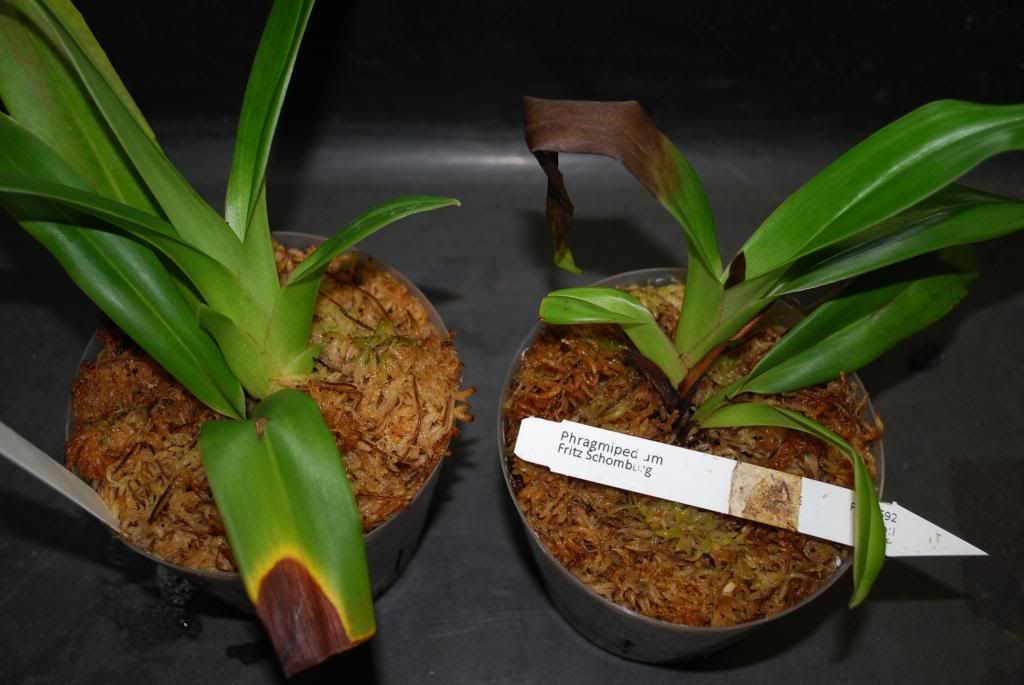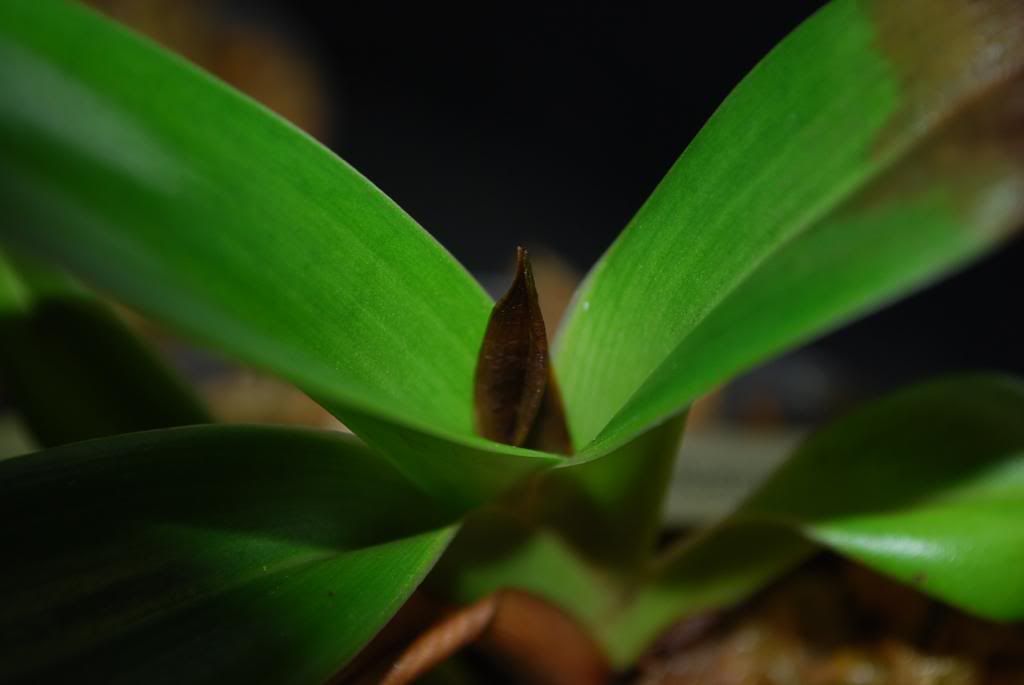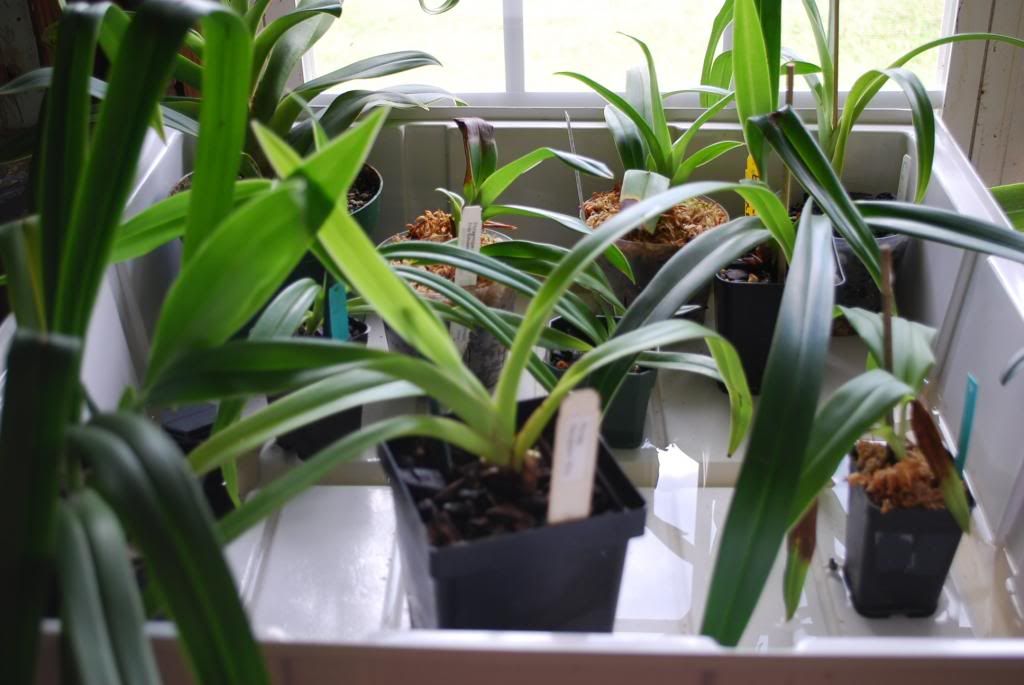You are using an out of date browser. It may not display this or other websites correctly.
You should upgrade or use an alternative browser.
You should upgrade or use an alternative browser.
Phrag problem
- Thread starter newbud
- Start date

Help Support Slippertalk Orchid Forum:
This site may earn a commission from merchant affiliate
links, including eBay, Amazon, and others.
The Orchid Boy
Well-Known Member
Kinda looks like what's happening on a friend's Encyclia cordigera. Curious to see what it is.
newbud
Orchid Maniac
Yeah, me too. I'm wondering if it's too wet. I grow them in a flow table but without the flow. I put about an inch of water in and let it evaporate then fill it up again. I have a fan going all day but shut it off at night. Out of the ten Phrags I have in there it is the only one with a problem.
mrhappyrotter
Grand Chupacabra
You say you let the water evaporate then refill. That may present a couple of problems. First, that may allow the plant(s) to dry out a bit too much between waterings. Second, that kind of regimen allows salts and nutrients to build up. If you don't regularly flush the pots with fresh, clean water, that's one thing you can address. There are a lot of phrags that don't like to stay wet, Fritz Schomburg is not one of them.
What's the plant potted in? Is that pure sphag? What's your fertilizing routine (frequency, strenght, product(s))?
Anyway, if all your other phrags are happy except the one, then there's a good chance that there's some specific cultural requirement that's not being met for that plant. In this case, it may be that Fritz simply doesn't handle fertilizer build up or drying out quite as well as the other phrags. It may be that the mix is too acidic for it. Maybe the conditions are a bit too warm for it, but fine for the others?
What's the plant potted in? Is that pure sphag? What's your fertilizing routine (frequency, strenght, product(s))?
Anyway, if all your other phrags are happy except the one, then there's a good chance that there's some specific cultural requirement that's not being met for that plant. In this case, it may be that Fritz simply doesn't handle fertilizer build up or drying out quite as well as the other phrags. It may be that the mix is too acidic for it. Maybe the conditions are a bit too warm for it, but fine for the others?
mrhappyrotter
Grand Chupacabra
As a bit of a tangent, I had several phrags of a Jason Fischer cross that used to perform similarly to your F.S. They would grow for a bit, then get horrible rot & die back. Over the years, I tried all kinds of corrective measures: more water, less water, different fertilizer, less fertilizer. I tried increasing and reducing humidity, I reduced temps, experimented with different potting mixes -- basically I tried a lot of different approaches. Some would seem to work for awhile, then the die back would happen again.
Fast forward a bit, I got frustrated and put the plants in "suboptimal" spots, I had resigned myself to the fact that they were all going to suffer and die, so I didn't want to have to watch. And of course, the die back stopped. Literally, the only factor that seemed to change was lower light levels. Sure enough, now that I keep those phrags in much shadier conditions than I keep all the others, they no longer suffer from the die back.
The point of this is not to stick your F.S. in the shade, it's that different plants can have slightly different cultural requirements and sometimes you have to experiment to find what works.
Fast forward a bit, I got frustrated and put the plants in "suboptimal" spots, I had resigned myself to the fact that they were all going to suffer and die, so I didn't want to have to watch. And of course, the die back stopped. Literally, the only factor that seemed to change was lower light levels. Sure enough, now that I keep those phrags in much shadier conditions than I keep all the others, they no longer suffer from the die back.
The point of this is not to stick your F.S. in the shade, it's that different plants can have slightly different cultural requirements and sometimes you have to experiment to find what works.
SlipperFan
Addicted
I'm a believer in low K. I was having a terrible problem with erwinia on my Phrags. I'd find the rot on a couple different Phrags every day. I'd treat them and it seemed like it just kept getting worse. That was back when Rick was explaining about how he controlled that problem by cutting back on the K in fertilizer. Then he and Ray came up with K-Lite, and Ray started selling it. I've been using it now for several months, and gradually the erwinia problem is dissipating. I still see it occasionally, but I think it will gradually disappear.
newbud
Orchid Maniac
thanks a lot for your responses. I use K-lite and sea weed weekly. K-lite for about 6 -9 months now. I don't ever let my Phrags dry out, just let the water in the pan dry down so it doesn't get stagnant. These were in my house in the corner of the living room in a tray and the light was from two windows but it was in the corner so it was never direct. The black stuff started in there. I brought them out into the garage when the weather permitted about the first of June. Put them in the flow table and keep them moist, not soaking wet but moist. They are in sphagnum and it's been over a year since potting them up. I think it's definitely time for a repot. Should I try a bark mix?
NYEric
Well-Known Member
The rot in the center comes from too much moisture; either from watering into the crown or too much humidity. Some people put cinnamon in the area because of it's hydrophobic nature and maybe medicinal properties. I use lime powder for this. There is a product, Dragonsblood from Shop gone wild/ The Healing Forest, which works well on the problem. Maybe the sphagnum is staying too moist and cool; I would put them in S/H.
Last edited:
The Orchid Boy
Well-Known Member
Maybe try a fan blowing directly or indirectly on them.
SlipperFan
Addicted
I'd take them out of sphagnum and put them in a bark mix.
Change the media.
The sphagnum decomposing has probably nullified the K-lite by releasing too much potassium to the plant.
Change the media to any fresh media even if you stay with sphag, change it to fresh moss.
The sphagnum decomposing has probably nullified the K-lite by releasing too much potassium to the plant.
Change the media to any fresh media even if you stay with sphag, change it to fresh moss.
Rick
Well-Known Member
thanks a lot for your responses. I use K-lite and sea weed weekly. K-lite for about 6 -9 months now. I don't ever let my Phrags dry out, just let the water in the pan dry down so it doesn't get stagnant. These were in my house in the corner of the living room in a tray and the light was from two windows but it was in the corner so it was never direct. The black stuff started in there. I brought them out into the garage when the weather permitted about the first of June. Put them in the flow table and keep them moist, not soaking wet but moist. They are in sphagnum and it's been over a year since potting them up. I think it's definitely time for a repot. Should I try a bark mix?
Hi Jack
Did you ever get your dosing and conductivity figured out? The last set of numbers looked like you were dosing your feed way too high (regardless of what type of fert you are using). For phrags you can get lots of growth fertilizing at less than 20ppm N once a week. I have a huge Phrag longifolium that just keeps getting bigger getting 5ppm N almost daily, and its kept in a tray of water. But I also have besseae, kovachii, and dalesandroi doing very well with heavy watering but very light frequent feedings.
Also K doesn't leave old leaves just by feeding low K. It can get recycled from the old leaves into new growth, but old growth that is already impacted with high K (and has more K than Ca in its tissue) will be as susceptible to rots as the good old days until the plant turns over the older growths.
BTW I have blooms on that Phalae minus!!
Similar threads
- Replies
- 48
- Views
- 8K
- Replies
- 3
- Views
- 2K





